Molecular investigation of the frequency of Cryptosporidium parvum in feces of calves with diarrhea in Alborz province
Subject Areas : clinical veterinary science
رضا حسینی
1
![]() ,
Milad Hamzehali Tehrani
2
,
Milad Hamzehali Tehrani
2
![]() ,
Navid Sadeghi
3
,
Navid Sadeghi
3
1 - استادیار، گروه آموزشی انگل شناسی،دانشکده دامپزشکی، واحد شهرکرد، دانشگاه آزاد اسلامی،شهرکرد، ایران
2 - گروه پاتوبیولوژی- دانشکده دامپزشکی- واحد علوم و تحقیقات تهران- دانشگاه آزاد اسلامی نهران
3 - Department of Pathobiology, Islamic Azad University, Karaj Branch, Karaj, Iran.
Keywords: Calves of Alborz province, Cryptosporidium parvum, Feces, Karaj, Molecular investigation,
Abstract :
Background: Cryptosporidium is one of the main causes of disease and mortality in young livestock and is also one of the most important intestinal agents in mammals, especially domestic animals and humans. Clinical symptoms in affected animals are diarrhea, malabsorption, weight loss, and milk loss. Due to the zoonotic nature of this parasite, it is very dangerous for human societies. Nowadays, Cryptosiridium is considered as one of the etiological factors of infant diarrhea syndrome in ruminants, especially in calves. It is associated with a gastrointestinal infection or it causes diarrhea independently. Objectives: This study aimed to investigate the molecular prevalence of Cryptosporidium parvum in the feces of calves with diarrhea in Alborz province. Methods: After collecting 52 diarrhea samples from 12 calves from cattle ranches in Alborz province and transferring them to the laboratory, DNA extraction was performed, then PCR was performed using RFLP-PCR method. The test results were analyzed by SPSS software. Results: 7% of the samples out of 52 were infected with Cryptosporidium, after testing and analysis, it was found that 2 were parvum, also the probability of infection with Cryptosporidium parvum in calves under 1 months is more than that of 1 to 6 months of age, but the level is significant Not seen in this case. Conclusions: According to the results obtained in this study and the review of past reports, it shows that the prevalence of infection with Cryptosporidium parvum parasite in the cattle farms of Alborz province is low compared to other parts of Iran. However, due to the joint infection of humans and animals by this parasite, appropriate preventive and therapeutic measures should be taken to eradicate this parasite.
1. Wang D, Jiang P, Yang X, Zhang J, Chen T, Hu M, Cacciò SM, Yin J, Zhu G. Novel strategy to quantify the viability of oocysts of Cryptosporidium parvum and C. hominis, a risk factor of the waterborne protozoan pathogens of public health concern. Water Res. 2024 May 28;258:121788.
doi: https://doi.org/10.1016/j.watres.2024.121788
PMID: https://pubmed.ncbi.nlm.nih.gov/38810599/
2. Ross R, Hasheminasab SS, Conejeros I, Gärtner U, Kamena F, Krueger A, Taubert A, Hermosilla C. Human dendritic cell interactions with the zoonotic parasite Cryptosporidium parvum result in activation and maturation. Front Immunol. 2024 May 10;15:1388366.
doi: https://doi.org/10.3389/fimmu.2024.1388366
PMID: https://pubmed.ncbi.nlm.nih.gov/38799470/
3. Karimi, G., paikari, H., Rivaz, S., Nasiri, V., Abdi godarzi, M., Ranjbar, M. M. Isolation and identification of Cryptosporidium spp. in diarrhetic calves in Alborz province. New Findings in Veterinary Microbiology, 2020; 2(2): 32-40.
doi: https://dorl.net/dor/20.1001.1.26454491.1398.2.2.5.5
4. Zarghami, F., Mokhberdezfouli, M., Rahbari, S., Shayan, P., Ebrahimzadeh, E., Boloorchi, M., Lotfolahzadeh, S. A study of oocyst shedding pattern and weight changes in neonatal calves experimentally infected with Cryptosporidium parvum. Journal of Veterinary Research, 2015; 70(3): 241-248.
doi: https://doi.org/10.22059/jvr.2015.55264
5. Noorani Kolije, O., Yakhchali, M., Malekifard, F. Study on Cryptosporidium Infection in Cattle and Water Buffaloes of Farms in Mahabad Suburb, Iran. Journal of Veterinary Research, 2020; 75(2): 147-155.
doi: https://dorl.net/dor/20.1001.1.20082525.1399.75.2.3.6
6. Keyvanloo Shahrestanakey R, Taghavi Razavizadeh A, Razmi G. A survey on Cryptosporidium spp. infection in lambs with and without clinical signs of diarrhea in Jovein area. Veterinary Clinical Pathology The Quarterly Scientific Journal. 2017 Nov 22;11(3 (43) Autumn):233-41.
7. Vahedi N, Dalimi Asl AH, Saadat M. Primary Research on Gastro-Intestinal Cryptosporidium Incidence Rate in Lambs and Calves in Amol city, Iran. J Vet Res. 2009;64(2).
8. Ranjbar-Bahadori, S., Toni, S. Infection to Cryptosporidium in diarrheic calves: A provincial study in southern Khorasan. Journal of Veterinary Research, 2013; 68(1): 13-19.
doi: https://doi.org/10.22059/jvr.2013.30179
9. Sazmand A, Rasooli A, Nouri M, Hamidinejat H, Hekmatimoghaddam S. Prevalence of Cryptosporidium spp. in Camels and Involved People in Yazd Province, Iran. Iran J Parasitol. 2012;7(1):80-4.
PMID: https://www.ncbi.nlm.nih.gov/pmc/articles/PMC3488825/
10. Kaupke A, Rzeżutka A. Emergence of novel subtypes of Cryptosporidium parvum in calves in Poland. Parasitol Res. 2015;114:4709–16.
doi: https://doi.org/10.1007/s00436-015-4719-1
PMID: https://pubmed.ncbi.nlm.nih.gov/26358098/
11. Lombardelli JA, Tomazic ML, Schnittger L, Tiranti KI. Prevalence of Cryptosporidium parvum in dairy calves and GP60 subtyping of diarrheic calves in central Argentina. Parasitol Res. 2019;118:2079–86.
doi: https://doi.org/10.1007%2Fs00436-019-06366-y
PMID: https://www.ncbi.nlm.nih.gov/pmc/articles/PMC7087732/


